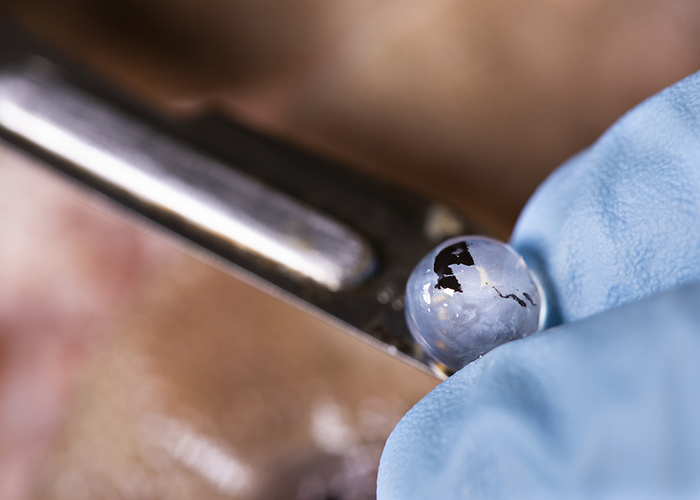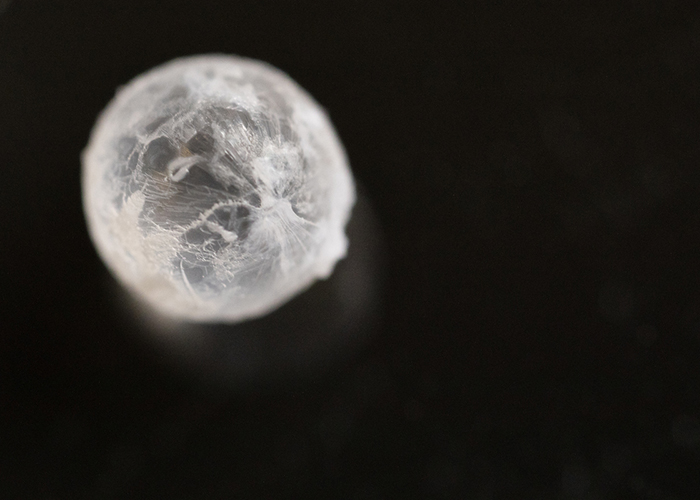USF scientists dissect fish eyes to track change in oceans
Cutting-edge research at the USF College of Marine Science looks at the lenses in fish eyes to provide answers about environmental change and the health of our oceans. Learn more about what they are discovering.
Julie Vecchio looks into a microscope at the University of South Florida College of Marine Science in St. Petersburg and deftly wields a set of tweezers.
She carefully separates layers of paper-thin tissue from a tiny, round object. It’s a task like peeling an onion, only more delicate and it doesn’t make your eyes water. That’s because the object she’s dissecting is the lens from the eye of a fish.
Vecchio is a fourth-year Ph.D. student in the marine resource assessment program. She is studying the internal chemistry of fish on the West Florida Shelf, an area in the Gulf of Mexico known for its abundance of grouper and snapper prized by both diners and fishermen.
The immediate goal is to get answers about the diet of the fish, their habitat and living conditions, as well as their movements underwater over their lifespan.
The bigger picture is about sustainability. Her research can help give clues about the health of our oceans and the impact that environmental challenges like pollution, red tide, climate change, and over-fishing can have on marine life.
Studying the internal chemistry of fish to learn more about the external chemistry of the ocean environment is not a new idea. But the technique Vecchio is using to do her research and the questions she is asking are innovative.
Fisheye lenses?
Usually, researchers tag the fish by placing a small plastic implant on the body. That allows them to catch the fish later and learn about growth and movement. Instead, Vecchio is analyzing the lens of the fisheye, which is like studying the rings of a tree.

Looking at the rings of a tree can help scientists estimate climate variations, drought and other conditions that have taken place over the lifetime of the plant. In fish, each layer of the lens corresponds to where they were and what they ate during a certain time in their life.
“We can get comprehensive data of their entire lifespan, back to the time they are born,” says Vecchio. “We are the first people in the world to be looking at the fish eye lenses in this way. This is a new application of the technology and the data.”
The fish eyes arrive frozen. Once they’ve been defrosted, Vecchio removes the lens, which is usually around 1 inch in diameter for fully mature fish. Then she separates the layers — the largest eyes can have up to 30 layers. The center of the eye is only 1/16 of an inch in diameter, so this task requires serious manual dexterity. Each layer goes into a small plastic tube, which is then dried overnight in an oven.
“The result is like a tissue paper sample of pure protein,” says Vecchio.
Chemical composition
From there, the proteins are placed in an isotope ratio mass spectrometer.
“We’re looking at isotopes of carbon and nitrogen in the protein. What we find can tell us something about the location of the fish when that layer was formed,” says Vecchio. “Within the West Florida Shelf, there is a gradient of chemistry. The northern area is high in nitrogen and the southern end is low; the middle is in between.”
“The fish incorporate the chemistry of the place in which they are living,” explains Vecchio. “I can get chemical information from each layer to determine where they’ve been and what they’ve been eating over their lifespan.”

Why is that important? For one, the data can help pinpoint the location of fish spawning grounds and “nurseries” so they can be better protected for the sustainability of the fishing industry.
The data can also help organizations such as NOAA (National Oceanic and Atmospheric Administration) make recommendations for better marine regulations. It can also document the connection between the health of the bottom of the ocean and the health of fish who depend on marine life there as food.
“We’re not directly looking at climate change or red tide, but we can show that when eutrophication (excessive rich nutrients in the water due to runoff from the land) cause phytoplankton like a red tide to grow, it can shade the bottom and prevent marine life from growing there,” says Vecchio.
That’s a concern, she says, because grouper and other fish are dependent on food that lives at the bottom. The fish could potentially starve if their food source was gone.
Vecchio says she became “hooked” on marine science from the time she and her family first went to Sea World in Ohio when she was 10. She went on to earn her bachelor’s degree from Albion College in Michigan and a master’s degree in marine biology at the College of Charleston, where she also met her husband Chris Bradshaw.
The two moved to St. Petersburg for jobs with the Florida Fish and Wildlife Commission. Bradshaw is still there; Vecchio decided to pursue a doctorate at the USF marine college because she missed doing research.
“The answers we are getting are incredibly important to our understanding of the natural world and maintaining a healthy balance,” says Vecchio. “Anything we can do to understand more about the lifespan of fish will lead to greater sustainability in the long run.”
Follow the link to learn more about USF’s College of Marine Science.



















